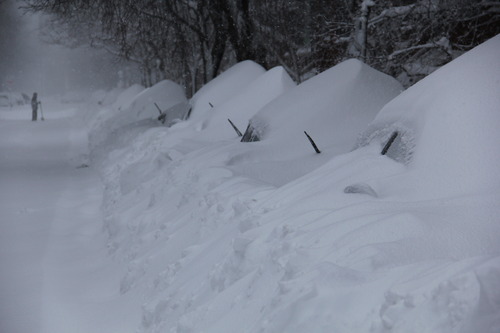This has been a relatively mild winter, and New Englanders are just about to say “Hello” to their first significant snow storm of 2015.
According to experts, New Englanders are about to be immobilized with the arrival of several feet of heavy white snow, which can make driving pretty scary. It’s always best to stay home and avoid traveling the roads. But in the event you must hit the road for whatever reason – a loaf of bread, milk or if you’re fresh out of Cheerios – we strongly recommend you read along and incorporate some of the following tips while behind the wheel.
1. Remove snow from your entire vehicle before hitting the roads.
Why is this important? Safety and visibility. Last thing you need is any snow debris obstructing your vision or the driver’s vision behind you.
Get yourself a snow broom to avoid scratching your car. Snow brooms allow you to push heavy, wet snow off the roof, hood or any hard-to-reach place. This is especially true for owners of SUVs or Minivans. Many snow brooms have telescopic handles that can extend upwards of 50-inches allowing you maximum reach without much hassle. Some of these snow brooms have ice scrapers too, to assist with any ice buildup on the front and back windows.
2. Don’t follow the speed limit.
Forget speed limits for the day! … But not so fast. In the snow, driving is just about getting from Point A to Point B, and safely. The best way to do that? Drive below the posted speed limit. Only drive as fast as it is safe to drive. If you’re cruising along a 35-MPH zone but your car is slip-sliding away, maybe it’s time to slow down. If you’ve got traffic piling up behind you wanting to get past, pull over and let them pass. Winter is no time to cave to peer pressure to drive faster than you’re comfortable or capable. Better to get there eventually than not at all.
3. Check the condition and air pressure of your tires.
If you’ve already had them checked by your local auto mechanic, there’s probably little to worry about. But if you haven’t checked the tire tread and the air pressure, do so immediately. These are critical to safe travel. If your tire tread is not adequate, quickly get your tires replaced. There is still time. There are tire-tread indicators in the tire that will tell you the tire is near end of life.
Check your tire pressure. Your manufacturer’s recommended PSI (Pounds per Square Inch) for your tires is listed inside the driver’s door on a sticker or in the owner’s manual. For driving in the snow, experts recommend inflating about 3-5 PSI higher to increase tire stability and help increase your tires’ responsiveness. After the storm is over, reduce pressure to the proper recommended rating.
4. Don’t follow too closely behind the next car.
Leave twice the normal space you’d leave for a safe following distance to account for not being able to stop in time. One of the most common mistakes people make when driving in snowy conditions is to follow too closely in traffic, which can lead to pileups. Don’t be the cause of a pileup (or a participant in one!). Keep your distance. And keep two hands on the wheels at all times. Forget the mobile phone!
5. Don’t forget to keep a winter emergency kit in your car at all times.
You can either buy one from an auto parts store or you can make one yourself. Whatever method you prefer, make sure you never leave the house in wintry conditions without having that little lifesaver in your backseat or trunk. Common ingredients of a great winter-emergency roadside kit includes a flashlight, road flares, a first aid kit, extra clothes, gloves, blankets, chemical hand warmers, a fully charged spare cell phone, and a small shovel to help dig you out in case you get stuck.
Driving in winter doesn’t have to be a game of roulette. As long as you take certain precautions and use your head wisely, you should be able to weather the storm without any horror stories to tell, come the spring thaw.
Save upwards of 25% on
car repair and maintenance services with Openbay+

